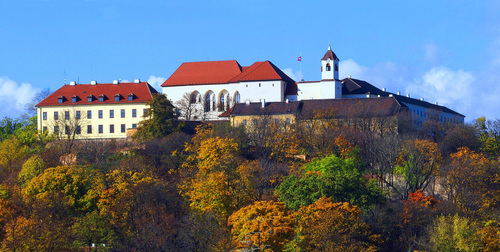



This is an area of important natural, economical and cultural potential of the Czech Republic. Moravia had always in the past a privileged political and administrative status. This is also the place of the first Czech state unit called the Great Moravian Empire. Its monarchs invited missionaries Cyril and Methodius from Thessalonica, who brought Christianity to the Czech countries. History is omnipresent. You can admire boundless verdure of valleys decorated by splendid castles and fortifications inherited from the 9th century. The region along the Dyje River (in 2000 declared as a national park connected to another national park in Austria) is an ideal place for walking and cycling tours. One of the unforgettable places in South Moravia is Moravian Karst with its astounding array of caves. Very attractive for tourists are boat rides along the romantic subterranean river Punkva, which take you through its large system of stalagmite and stalactite caves to the bottom of the 139 m Macocha Abbys, the deepest place in the Czech Republic. Apart from the well-known Punkva Cave there are other fascinating caves worth seeing such as Sloupsko-Sosuvské Caves which are visited not only for beauty of its stalagmites and stalactites but also for curative effects on breathing problems. Furthermore, choral concerts take place in Eliscina Cave. One of the largest stalagmite and stalactite caves in the Moravien Karst is called Katerinská Cave. Apart from the natural treasures (such as the Moravien Karst) there are historical monuments which pride themselves on being included in the Heritage list of UNESCO - the area in the south-east of Pálava with the complex of Lednice-Valtice with its baroque chateau and wonderful English park surrounding this complex. One of the most remarkable places in the Czech Republic is the second largest city Brno. Brno, which used to be in the past a centre of all Moravia) is presently famous for its trade fairs and exhibitions. In the town you can admire beautiful architecture of many cathedrals and churches, museums and galleries. Don’t miss out the visit to the Parnassus Fountain designed by J. B. Fischer of Erlach in 17th century. Well known is Brno’s baroque fortress Spilberk built between the mid-17th century and the end of the 18th century, now-a-days housing the Museum of the City of Brno. Close to Brno there are other places, which played an important role in history such as Zurán hill from which Napoleon Bonaparte commanded his troops in the first part of Battle of Austerlitz (this event is remembered by a memorial stone with plan of the battlefield). Further north from here there is the Slavkov Castle, where the victorious Napoleon signed the peace treaty. Favorite place for all walkers is the Vranovská Dam with its network of footpaths. The Palava Nature Reserve is a lovely place where you find rare flora and fauna, cliffs of chalky limestone (popular among climbers) and a large artificial lake. Mikulov is an important wine-growing and cultural centre of South Moravia. Znojmo is another town well known for its wine and pickled-gherkin production. The history of Znojmo dates back to the 11th century. There is a fabulous historical centre with a number of preserved baroque and renaissance buildings and underground passages from the 15th and 17th century. A wine-growing festival takes place there every September. Stráznice is the town with a strong tradition of folk culture, ceramics, and is fabled through its yearly folk festival, which takes place during the last weekend in June. Here you meet the real spirit of the South Moravians, their love for traditions and relaxed enjoyment of hand-made costumes, colour, cheerful music, delicious wine and plum brandy. South Moravia with its traditions and nice friendly people let you never forget your stay here.